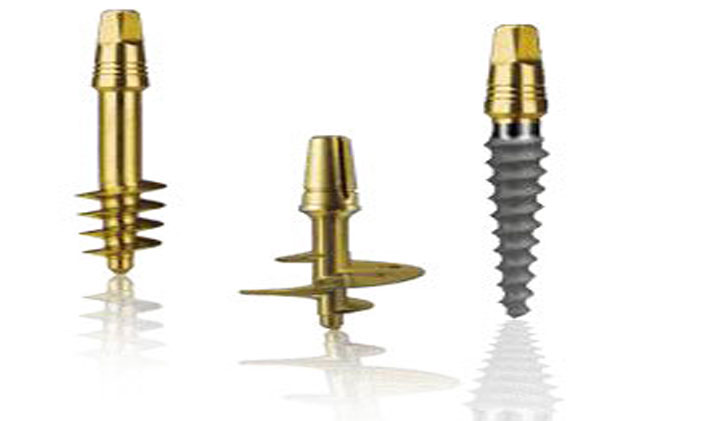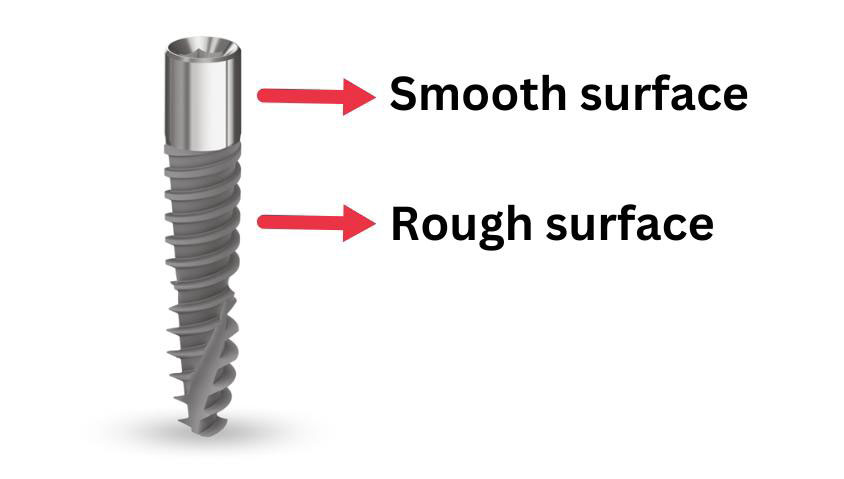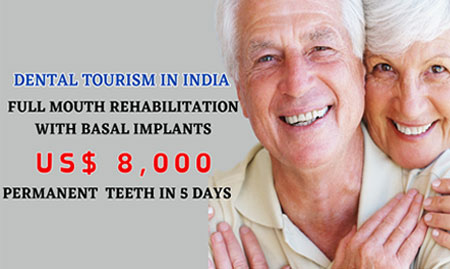
Dr. K Sharada Reddy, Author
Senior Dentist & Full Mouth Rehabilitation Expert
Dental implantology has evolved tremendously over the past few decades. Conventional dental implants have long been considered the gold standard for fixed teeth replacement. They provide excellent long-term success through Osseo Integration, ensuring a stable and natural foundation for crowns or bridges. However, conventional implants often require additional surgical procedures such as sinus lifts before dental implants, dental bone grafts, or ridge augmentations, especially in patients with poor bone volume. These steps not only increase the treatment time and cost but also subject the patient to invasive and time-consuming surgeries, delaying the final prosthetic loading by several months.

To overcome these drawbacks, basal implants were introduced as an alternative. The main advantage of basal implant systems was their ability to provide immediate loading dental implants without bone grafting. They utilize the basal cortical bone, which is denser and more stable, allowing the placement of implants even in cases of severe bone loss. This approach aimed to reduce treatment duration and avoid complex grafting procedures, making it a seemingly faster and less invasive option.
However, despite addressing the limitations of conventional implants, basal implants introduced a new set of challenges. Unlike conventional implants that
Osseo Integrate with bone, basal implants rely on Osseo fixation, meaning they are mechanically anchored in cortical bone without forming a true biological bond. This can lead to long-term stability issues and potential implant failure over time. Moreover, basal implants are single-piece implants, which limit prosthetic flexibility. During placement, these implants are often positioned at an angulation to engage available cortical bone and avoid critical anatomical structures like the maxillary sinus or inferior alveolar nerve. Since the abutment and implant body are a single unit, angulation cannot be corrected at the gum level, posing significant challenges for proper prosthetic alignment. In many cases, dentists resort to bending the implant neck to correct angulation, which risks implant fracture, bone crack, or loss of implant stability, compromising the site for future placement.
Another major limitation is that basal implants are cement-retained, where bridges are permanently fixed using cement. This prevents easy retrieval or adjustment of the prosthesis, making maintenance and hygiene management difficult. Over time, trapped cement can also contribute to peri-implantitis and bone loss.

To overcome these short comings, modern implantology has shifted toward advanced protocols such as the Crestal Polished Bicortical Conventional Implant (CPBCCI) protocol. This innovative technique combines the advantages of conventional implant Osseo Integration with the benefits of bicortical engagement and immediate function Implants, without the drawbacks of basal systems. The CPBCCI protocol allows minimally invasive key hole implant placement through the crestal approach, eliminating the need for sinus lifts or bone grafts in most cases. It ensures excellent primary stability, ideal prosthetic angulation, and retrieve ability of restorations, while maintaining healthy peri-implant tissues due to its polished crestal design.
In essence, while basal implants served as a stepping stone in the search for graft less, immediate implant restorations, the CPBCCI protocol represents the next generation in implant dentistry offering precision, biological integration, prosthetic flexibility, and long-term success. For patients and clinicians seeking a safe, effective, and evidence-based alternative to both grafting and basal techniques, the CPBCCI protocol stands as the true evolution in modern dental implantology.
A Breakthrough in Modern Implant Dentistry
The Crestal Polished Bicortical Conventional Implant (CPBCCI) protocol has revolutionized immediate-loading implantology. It combines the biological success of conventional implants with the mechanical advantages of bicortical anchorage, while eliminating the drawbacks of basal implants and traditional implant systems.
Key Design Features and Benefits
Bicortical Engagement:
CPBCCI implants are strategically placed to engage two cortical plates (bicortical anchorage), ensuring exceptional primary stability even in soft or deficient bone allowing immediate function implants without bone grafts or sinus lifts.
Polished Crestal Design:
The polished crestal portion of the implant prevents bacterial colonization, maintaining healthy gum tissues and preventing symptoms of peri-implantitis, providing implants for diabetic patients and safe implants for smokers.
Use of Multi-Unit Abutments:
Multi-unit abutments (MUAs) are one of the most critical innovations in the CPBCCI protocol. These abutments:
- Allow angulation correction without bending the implant.
- Enable ideal prosthetic alignment, ensuring that the bridges are perfectly parallel and esthetically pleasing.
- Distribute occlusal forces evenly across the implants, reducing stress on bone and prosthesis.
- Provide screw-retained restorations, making bridges retrievable for hygiene maintenance or repair.
This system eliminates the need for bending implants and allows customized
prosthetic solutions, offering long-term safety and stability.
Safe for Diabetic and Smoking Patients:
The CPBCCI protocol is ideal for medically compromised individuals such as diabetics and also smokers, as it avoids bone graft for dental implants(which may fail in poor-healing cases) and ensures a clean crestal zone due to the polished implant surface. Faster healing, reduced inflammation, and minimal surgical trauma make it a safer, more predictable choice for such patients.
Comparison Table: Basal Implants vs CPBCCI Protocol
| Parameter | Basal Implants | CPBCCI Protocol (Crestal Polished Bicortical Conventional Implants) |
|---|---|---|
| Implant Design | Single-piece | Two-piece with multi-unit abutments |
| Type of Bone Used | Basal cortical bone | Crestal and bicortical bone |
| Integration Type | Osseofixation (mechanical) | Osseointegration (biological bonding) |
| Abutment System | Fixed abutment (non-adjustable) | Multi-unit abutments for angulation correction |
| Retention Type | Cement-retained | Screw-retained, retrievable |
| Angulation Correction | Requires bending; risky | Achieved easily using multi-unit abutments |
| Risk of Fracture | High due to bending stress | Negligible |
| Maintenance | Difficult; bridge not retrievable | Easy; retrievable screw-retained prosthesis |
| Peri-implant Tissue Health | Poor due to cement and bacterial accumulation | Excellent due to polished crestal design |
| Suitability for Diabetic/Smoking Patients | Risky due to infection and healing issues | Safe due to minimal invasion and polished surface |
| Need for Bone Grafts/Sinus Lifts | Not required | Not required; crestal approach used |
| Loading Protocol | Immediate | Immediate loading |
| Long-term Success | Moderate; not FDA approved | High; due to biological and prosthetic advantages, FDA approved |
| Best Suited For | Severely resorbed ridges with limited options | Full mouth rehabilitation, posterior jaw, diabetics, smokers |
| Overall Benefit | Quick, graftless but mechanically dependent | Predictable, retrievable, biologically stable, long-lasting |
Conclusion
While basal implants once offered a graft-free, immediate-loading solution, their mechanical design and prosthetic limitations restricted long-term reliability.
The CPBCCI protocol, with its two-piece bicortical implants, multi-unit abutments, and polished crestal surface, provides a scientifically sound, biologically integrated, and prosthetically precise alternative.
It is a safe, minimally invasive, and predictable treatment option even for diabetic and smoking patients making it the future of modern dental implantology.
If you are seeking full mouth dental implants in Hyderabad, consult Dr. K. A. Reddy at LBR Dental and Implant Center, a global leader in the CPBCCI protocol, offering immediate fixed teeth without bone grafts or sinus lifts safely, efficiently, and predictably.
Frequently Asked Questions
Basal implants were developed to overcome the limitations of conventional implants, particularly the need for dental bone grafts, sinus lift surgery, and delayed loading dental implants. They use dense cortical bone, allowing immediate implant placement without bone grafting. However, they only achieve mechanical fixation (osseofixation) and not true biological bonding (osseointegration), leading to long-term complications.
Basal implants, though initially beneficial, present several clinical challenges:
- Do not bond well with the bone, only mechanical fixation, posing problems in the long run.
- No angulation correction: The implant and abutment are a single unit.
- Bending required: Correcting angles by bending may lead to implant fracture or bone crack.
- Non-retrievable prosthesis: Cement-retained bridges cannot be removed easily.
- Risk of infection: Trapped cement can cause peri-implantitis.
- Mechanical fixation: Lack of osseointegration can compromise long-term success
The CPBCCI protocol resolves all the major drawbacks of basal implants:
- Uses bicortical anchorage for high primary stability.
- Achieves true osseointegration for biological bonding.
- Incorporates multi-unit abutments (MUAs) to correct angulation without bending.
- Allows screw-retained prosthetics for easy retrieval and hygiene.
- Reduces risk of peri-implant inflammation due to polished crestal design.
- Enables same day dental implants safely and predictably
Multi-unit abutments are vital in ensuring the success of CPBCCI implants. They:
- Correct implant angulation for ideal prosthetic alignment.
- Allow passive fit of bridges, preventing tension and screw loosening.
- Enable retrievability, so bridges can be unscrewed for cleaning or repair.
- Provide better force distribution, improving longevity.
- Make the system maintenance-friendly and comfortable for patients.
These features make the CPBCCI protocol superior in both clinical performance and patient comfort.
Yes. The CPBCCI protocol is exceptionally safe for diabetics and smokers because:
- The surgical approach is minimally invasive, with little bleeding or trauma.
- The polished crestal portion prevents bacterial buildup and gum inflammation. The rough surfaced implant body helps in providing proper osseointegration.
- Immediate function implants avoids prolonged healing time that may be delayed in such patients.
- No bone grafts or sinus lifts are used, which minimizes infection risk and surgical complications.
- This makes CPBCCI implants ideal for patients who were once considered unsuitable for traditional implants.
Clinical data and long-term case follow-ups indicate that CPBCCI implants have an excellent success rate, often exceeding 95–98%, due to:
- Bicortical engagement for strong stability,
- Osseointegration for biological bonding,
- Prosthetic flexibility through MUAs, and
- Healthy crestal tissue maintenance with polished implant surfaces.
This combination ensures reliable, long-lasting results for full mouth dental implant rehabilitation and immediate loading protocols.




